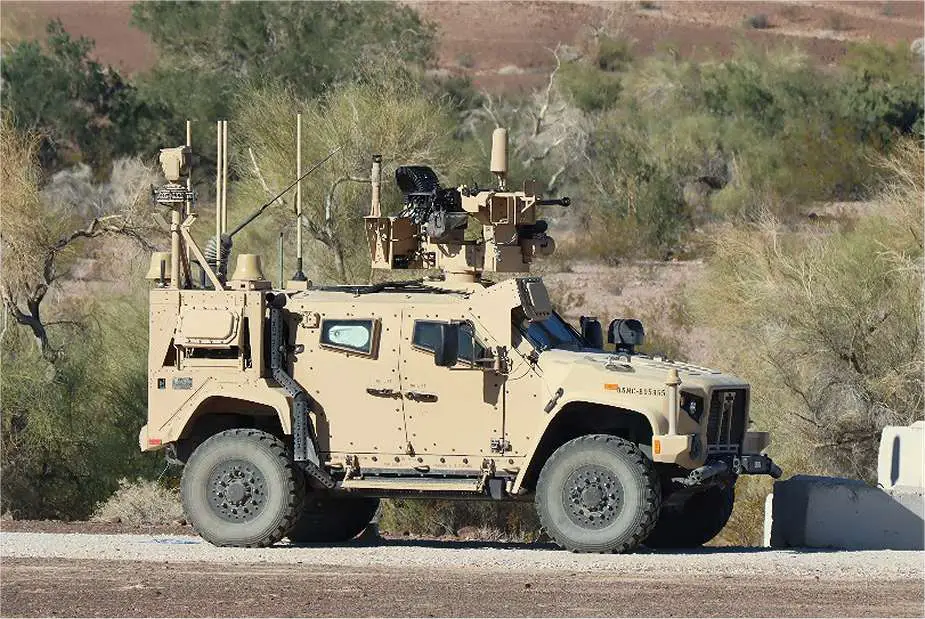Breaking news
US Marine Corps Boosts Its Air Defense Capabilities With New MADIS System.
The Marine Air Defense Integrated System (MADIS), an innovative air defense capability, has marked a significant enhancement in the U.S. Marine Corps' ability to counter unmanned aircraft systems. In a pivotal development this past December 2023, the Program Executive Officer Land Systems conducted a successful test of the MADIS low-rate initial production model. This test carried out at the Yuma Proving Ground in Arizona, saw the system effectively engage and destroy multiple drone targets during a live-fire exercise.
Follow Army Recognition on Google News at this link

U.S. Marines with Marine Corps Systems Command, fire a Stinger Missile from a Marine Air Defense Integrated System (MADIS) Mk1 vehicle at Yuma Proving Ground, Arizona, December 13, 2023. (Picture source U.S. DoD)
MADIS was subjected to realistic battlefield conditions, where it proficiently detected, tracked, identified, and neutralized aerial threats, showcasing its combat readiness.
As a short-range, surface-to-air defense mechanism, MADIS empowers Low Altitude Air Defense Battalions to effectively counter unmanned aerial vehicles as well as manned fixed-wing and rotary-wing threats. This system is mounted on two Joint Light Tactical Vehicles, forming a synergistic duo. It comprises several distinct components, including radar systems, surface-to-air missiles, and command and control elements. Simplified, one vehicle is designed to detect threats, while the other is equipped to engage them.
The increasing prevalence of commercially available drones poses a growing security challenge. MADIS addresses this threat through instantaneous communication and coordination, allowing for the efficient neutralization of low-altitude aerial dangers, thereby protecting Marine Air Ground Task Forces.
During the recent testing phase, MADIS effectively used Stinger missiles and a 30mm cannon to track and eliminate multiple airborne targets. Data transmission through the Common Aviation Command and Control System enabled the vehicle pair to execute these engagements while simultaneously monitoring additional unmanned aerial systems (UAS).
According to military sources, the MADIS system operates with two JLTV vehicles working in tandem - the MADIS Mk1 and Mk2. The Mk1 primarily focuses on neutralizing fixed and rotary-wing aircraft, while the Mk2, equipped with Counter-Unmanned Aircraft System (C-UAS) capabilities, also provides radar and command and control support. Additionally, the Marine Corps utilizes the Light MADIS (LMADIS), which integrates radar and electronic warfare systems on a Polaris MRZR platform, serving both as a developmental model and an interim C-UAS solution for Low Altitude Air Defense (LAAD) battalions.
The Mk1 variant is armed with a missile pod carrying four Stinger missiles and a turret-mounted 30mm cannon. Handheld Stinger launchers inside the vehicle supplement its firepower. Lockheed Martin supplies the optical sensors for this weapon system.
Sierra Nevada Corporation produces the electronic warfare system, Modi II, for both MADIS variants. Recognized as the most advanced portable electronic countermeasure system in the Department of Defense's arsenal, Modi II is capable of disrupting enemy drones, communications, and radio-controlled improvised explosive devices (RCIED). It employs tactics like navigation system spoofing, communication jamming, and defeating weapon triggers to counter threats. Modi II follows the legacy of the Thor II/AN PLT-5 and Thor III AN/PLQ-9 systems.
The MADIS Mk2's radar component, the RPS-42 by RADA Electronic Industries Ltd., stands out for its ability to detect tiny radar cross-sections of commercial drones, which are increasingly used in modern warfare. This radar can identify targets within a 30km radius, at altitudes ranging from 30 to 30,000 feet. The Mk2 variant also features the same Modi II electronic warfare system as the Mk1.
For direct engagement, the MADIS Mk2 is equipped with an M134 Minigun, a powerful 7.62x51mm NATO six-barrel rotary machine gun capable of firing 2,000 to 6,000 rounds per minute.
Additionally, the Mk2 possesses a Beyond Line of Sight (BLOS) gateway/server capability as part of its command and control (C2) suite. This allows the vehicle pair to engage targets identified by other ground-based radar systems within the same network, enhancing its operational effectiveness.
Defense News January 2024




























